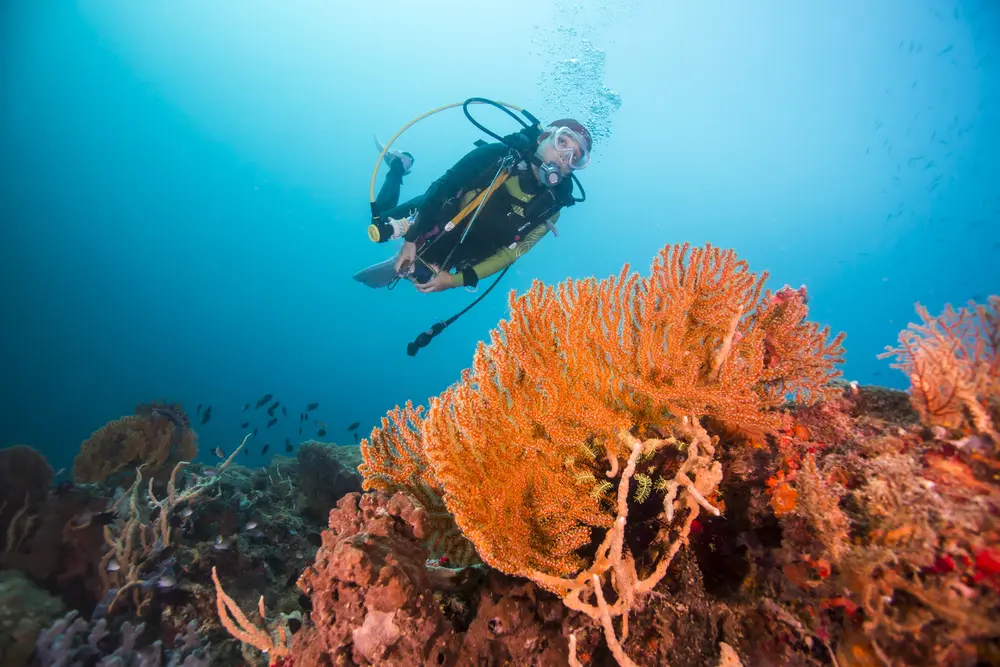What is the Great Barrier Reef?
Home to at least 9,000 different marine species, the Great Barrier Reef is one of the most complex ecosystems in the world. Fish dart amongst the coral, while turtles, dolphins, sharks and algae co-exist in 348,000 square kilometres.
Where is the Great Barrier Reef?
You can explore the Great Barrier Reef on Google Earth. This UNESCO World Heritage Site is so vast it can be seen from space. It extends for 2,300km along Australia’s northern coast, stretches up to 250km offshore and is up to 2,000 metres deep.
Why is the Great Barrier Reef important?
Snorkelling, swimming and diving in crystal clear waters attracts millions of people to the Great Barrier Reef every year. Under the water, you could see:
- Jellyfish – they have no heart, no brain and no blood but have survived for more than 500 million years
- Giant clams – live for around 100 years and can weigh up to 200kg
- Manta Ray – highly intelligent, they have the largest brain relative to body size of all known species of fish
- Sharks – there are so many types of shark that call different parts of the reef home, including hammerheads, tiger sharks, blacktips, whitetips and grey reef sharks
- Clownfish, Potato Cod (from the Grouper family), Parrotfish and Surgeonfish – just some of the fish that call the Great Barrier Reef home
- Whales – up to 10,000 whales migrate to the Great Barrier Reef to breed and give birth
Best ways to explore the Great Barrier Reef
The Great Barrier Reef has been a particular focus for conservationists when it comes to sustainable, ethical tourism. However, there are easy and cost effective ways to explore this modern-day wonder of the world:
- Great Barrier Reef snorkelling – There are many reasons the reef is so attractive to snorkellers: it’s safe, the water is clean and healthy, the colours are breathtaking and the marine life is usually safe and unbothered by snorkellers. It’s easy to forget the sun is still incredibly powerful even when you’re under the water, so wear protective gear.
- Great Barrier Reef scuba diving – There are incredible dive sites including wrecks and particular patches of the reef, as described by PADI, the world’s most recognised diving organisation with over 30 million members. There are sites for all levels of experience, from Stanley Reef for divers of all abilities to the SS Yongola shipwreck site for experienced divers only due to the strong current and depth.
- Great Barrier Reef cruises – You can hire a crew and go out on a private boat tour or, if you’re feeling sociable, join a larger group. Often these trips will include snorkelling and swimming time so you can explore the reef up close.
- Great Barrier Reef helicopter tours – You can get a breathtaking bird’s eye view of the reef by flying over it in a helicopter. The tour company will usually have a landing spot to allow you to disembark somewhere and swim, snorkel, or transfer to a submarine or glass-bottom boat to see the reef up close.
Packages are available so you can combine activities, depending on what you want to do. There are helicopter and snorkelling packages, for example, or cruises that run diving excursions as part of your package. Popular departure points include Port Douglas and Cairns, but you’ll find other departure points for tours along the coastline.
How to book tours of the Great Barrier Reef
Most sites advise booking your tours as early as possible because often capacity is limited and activities are incredibly popular. You can book through your travel agent.
Travel insurance
If you are planning a trip to the Great Barrier Reef, Travel Insurance is essential. You can speak to our insurance team if you have any questions about the most appropriate cover for your trip.
AllClear Travel Insurance can protect you for a number of unexpected events, including:
- Cancellations – In a medical emergency or under other circumstances.
- Delays – If your trip is delayed and you have to postpone, you could be entitled to compensation or cover for expenses through your travel insurance. Check your policy for terms.
- Accidents – If you do have an accident, you may need extra time to recuperate or you may need to be flown home early. Your policy can help you cover the costs if this happens.
- Illness – If you get sick and need to seek treatment, we can help. You don’t have to worry about losing out after you’ve paid for tours, even if they’re non-refundable.
- Lost gadgets or equipment – If you’re going snorkelling or diving, you may be bringing expensive GoPros or equipment. If they get lost or damaged in transport, gadget cover can help you offset some of the cost depending on your policy.
Travel Insurance can cover any trip away from home, even if you’re staying in the country. Make sure you have the right cover for your trip.
For full details of the benefits, terms and conditions, limits, sub-limits and exclusions that may apply, please refer to the relevant Combined Product Disclosure Statement and Target Market Determination.


